💼 Agricultural Budget
Learn about Budget 2023-24 from the perspective of Farmers 🧑🌾
Which of the following statment is wrong?
Budget
- On 1st February, 2023, Nirmala Sitharaman, the Minister of Finance and Corporate Affairs presented budget in the parliament.
- The Budget Division, part of the Department of Economic Affairs in the Finance Ministry, is responsible for preparing the Budget.
- The constitution does not explicitly mention the term Budget; instead, it refers to it as the Annual Financial Statement.
- As per Article 266 of the Constitution, obtaining Parliamentary approval is necessary to withdraw funds from the Consolidated Fund of India.
- Financial matters are addressed in Articles 112 to 117 of the constitution.
- Furthermore, Article 114 (3) of the Constitution states that no money can be withdrawn from the Consolidated Fund without the enactment of a law, specifically known as Appropriation Bill.
- An appropriation bill is a bill that authorizes the government to withdraw funds from the Consolidated Fund of India (CFI) for utilization throughout the fiscal year.
Background
- This is the first Budget of Amrit Kaal, mean after the completion of 75 years of India’s Independence.
- The Prime Minister gives a road map for the next 25 years for the country and this period is called Amrit Kaal and this is the first budget of Amrit Kaal.
- Azadi Ka Amrit Mahotsav is an initiative of the Government of India to celebrate and commemorate 75 years of independence and the glorious history of it’s people, culture and achievements.
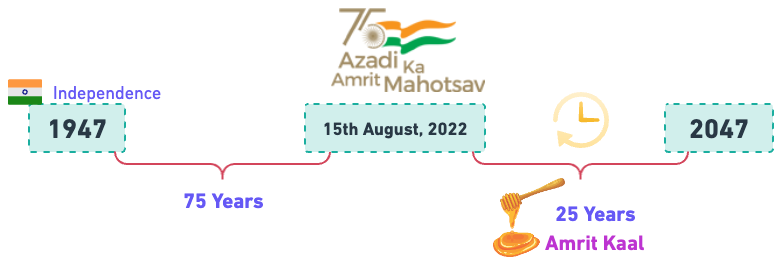
Vision for Amrit Kaal – an empowered and inclusive economy
- Government laid down the vison for these 25 years (Amrit Kaal)
- It includes technology-driven and knowledge-based economy with strong public finances, and a robust financial sector.
- To achieve this, Jan Bhagidari through Sabka Saath Sabka Prayas is essential.
- The economic agenda for achieving this vision focuses on three things:
- Facilitating ample opportunities for citizens, especially the youth, to fulfil their aspirations.
- Providing strong impetus to growth and job creation.
- Strengthening macro-economic stability.
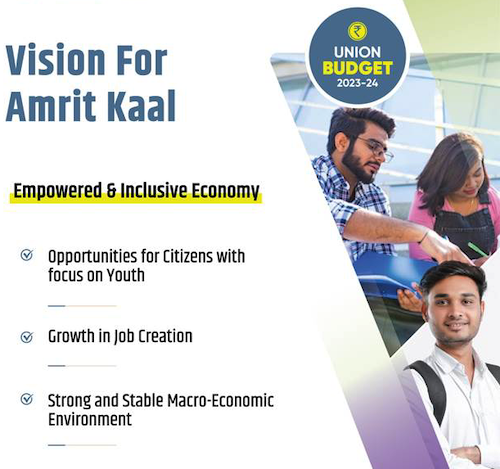
Achievements since 2014: Leaving no one behind
- Govenment also showed that it is moveing in the same direction as discussed in the vision for Amrit Kaal. It is ensuring Sabka Saath Sabka Vikas, means inclusive development.
- The government’s efforts since 2014 have ensured for all citizens a better quality of living and a life of dignity. The per capita income has more than doubled to 1.97 lakh.
- In these nine years, the Indian economy has increased in size from being 10th to 5th largest in the world. India has significantly improved our position as a well-governed and innovative country with a conducive environment for business as reflected in several global indices. Also India has made significant progress in many Sustainable Development Goals.
- The economy has become a lot more formalised as reflected in the EPFO membership more than doubling to 27 crore, and 7,400 crore digital payments of
126 lakh crore through UPI in 2022. - The efficient implementation of many schemes, with universalisation of targeted benefits, has resulted in inclusive development. Some of the schemes are:
- 11.7 crore household toilets under Swachh Bharat Mission,
- 9.6 crore LPG connections under Ujjawala,
- 220 crore Covid vaccination of 102 crore persons,
- 47.8 crore PM Jan Dhan bank accounts,
- Insurance cover for 44.6 crore persons under PM Suraksha Bima and PM Jeevan Jyoti Yojana, and
- Cash transfer of
Rs 2.2 lakh croreto over11.4 crore farmersunder PM Kisan Samman Nidhi.
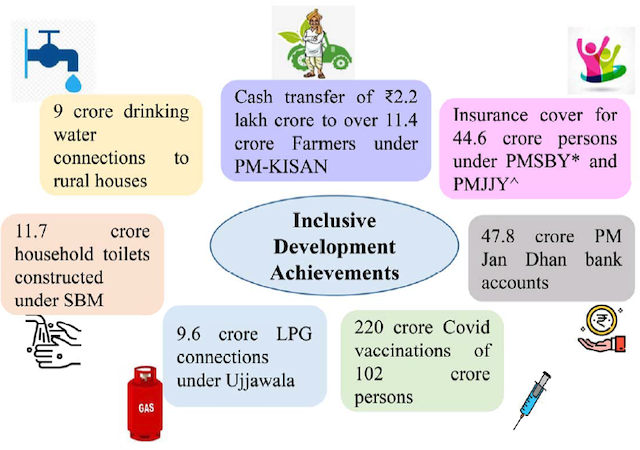
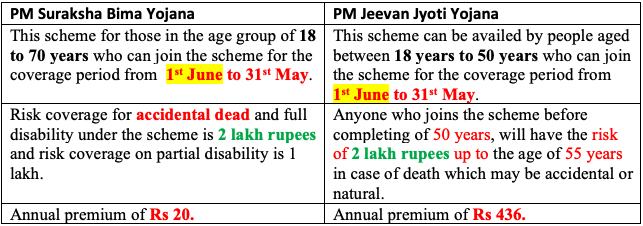
Resilience amidst multiple crises
- This Budget hopes to build on the foundation laid in the previous Budget, and the blueprint drawn for India@100. We envision a prosperous and inclusive India, in which the fruits of development reach all regions and citizens, especially our youth, women, farmers, OBCs, Scheduled Castes and Scheduled Tribes.
- In the 75th year of our Independence, the world has recognised the Indian economy as a bright star. Our current year’s economic growth is estimated to be at
7 per cent. It is notable that this is the highest among all the major economies. This is in spite of the massive slowdown globally caused by Covid-19 and a war. - Government will focus on wide-ranging reforms and sound policies, implemented through Sabka Prayas resulting in Jan Bhagidari and targeted support to those in need, helped us perform well in trying times. India’s rising global profile is because of several accomplishments:
- Unique world class digital public infrastructure, e.g., Aadhaar, Co-Win and UPI
- Covid vaccination drive in unparalleled scale and speed
- Proactive role in frontier areas such as achieving the climate related goals, mission LiFE, and National Hydrogen Mission.
- During the Covid-19 pandemic, Government ensured that no one goes to bed hungry, with a scheme to supply free food grains to over 80 crore persons for 28 months. Continuing the commitment to ensure food and nutritional security, we are implementing, from 1st January 2023, a scheme to supply free food grain to all Antyodaya and priority households for the next
one year, under PM Garib Kalyan Anna Yojana (PMGKAY). The entire expenditure of about 2 lakh crore will be borne by the Central Government. - G20 Presidency: Steering the global agenda through challenges. In these times of global challenges, the G20 Presidency will give India a unique opportunity to strengthen India’s role in the world economic order. With the theme of Vasudhaiva Kutumbakam, we are steering an ambitious, people-centric agenda to address global challenges, and to facilitate sustainable economic development.
Opportunities During Amrit Kaal
👉🏻 To service these focus areas in the journey to India@100, Government believe that the following four opportunities can be transformative during Amrit Kaal:
- Economic Empowerment of Women: Deendayal Antyodaya Yojana National Rural Livelihood Mission has achieved remarkable success by mobilizing rural women into
81 lakh Self Help Groups. Government will enable these groups to reach the next stage of economic empowerment through formation of large producer enterprises or collectives with each having several thousand members and managed professionally. They will be helped with supply of raw materials and for better design, quality, branding and marketing of their products. Through supporting policies, they will be enabled to scale up their operations to serve the large consumer markets, as has been the case with several start-ups growing into Unicorns. - PM VIshwakarma KAushal Samman (PM VIKAS): For centuries, traditional artisans and craftspeople, who work with their hands using tools, have brought renown for India. They are generally referred to as
Vishwakarma. The art and handicraft created by them represents the true spirit of Atmanirbhar Bharat. For the first time, a package of assistance for them has been conceptualized. The new scheme will enable them to improve the quality, scale and reach of their products, integrating them with the MSME value chain. The components of the scheme will include not only financial support but also access to advanced skill training, knowledge of modern digital techniques and efficient green technologies, brand promotion, linkage with local and global markets, digital payments, and social security. This will greatly benefit the Scheduled Castes, Scheduled Tribes, OBCs, women and people belonging to the weaker sections. - Tourism: The country offers immense attraction for domestic as well as foreign tourists. There is a large potential to be tapped in tourism. The sector holds huge opportunities for jobs and entrepreneurship for youth in particular. Promotion of tourism will be taken up on mission mode, with active participation of states, convergence of government programmes and public-private partnerships.
- Green Growth: Government is also implementing many programmes for green fuel, green energy, green farming, green mobility, green buildings, and green equipment, and policies for efficient use of energy across various economic sectors. These green growth efforts help in reducing carbon intensity of the economy and provides for large-scale green job opportunities.
7 Priorities of the Budget
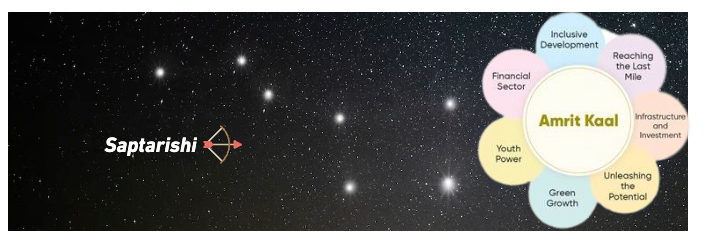
Saptarishi guiding us through the Amrit Kaal.
- Inclusive Development
- Reaching the Last Mile
- Infrastructure and Investment
- Unleashing the Potential
- Green Growth
- Youth Power
- Financial Sector
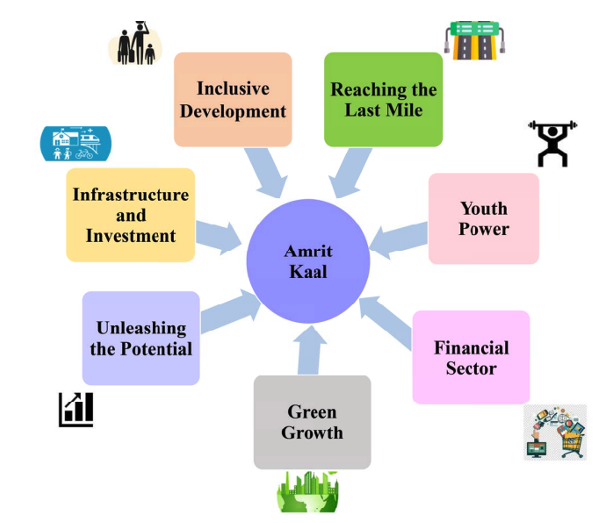
- Schemes related to agricultre are part of “Inclusive Development”. (1st Priority)
- The 7-point priority agenda of the Budget was the need of the hour to ensure a self-reliant, prosperous and US $5 trillion economy.
Inclusive Development
- The Government’s philosophy of Sabka Saath Sabka Vikas has facilitated inclusive development covering in specific, farmers, women, youth, OBCs, Scheduled Castes, Scheduled Tribes, divyangjan and economically weaker sections, and overall priority for the underprivileged (vanchiton ko variyata).
- There has also been a sustained focus on Jammu & Kashmir, Ladakh and the North-East. This Budget builds on those efforts.
Digital Public Infrastructure for Agriculture
- Digital public infrastructure for agriculture will be built as an open source, open standard and inter operable public good.
- This will enable inclusive,
farmer-centric solutionsthrough relevant information services for crop planning and health, improved access to farm inputs, credit, and insurance, help for crop estimation, market intelligence, and support for growth of agri-tech industry and start-ups. - This attempt of ensuring digital infrastructure for agriculture will not only bring in smart agriculture practices and modern data analyses based crop-planning and agri-development, but also would ensure incremental farm employment wherein educated and unemployed local youth would be attracted to render the required agri-services.
- This infrastructure push will incentivize banks and financial institutions in rolling out end-to-end digital solutions using relevant activity-specific data analytic models in rural areas.
- The digitalisation of agriculture describes integrating cutting-edge digital technology into the farm production system, including artificial intelligence (AI), robotics, uncrewed aviation systems, sensors, and communication networks.
- According to the NITI Aayog predicted in a report that by 2025, AI in agriculture would be worth $ 2.6 Bn and rise at a pace of 22.5 per cent Compound Annual Growth Rate (CAGR).
- AI currently helps farmers increase yield by assisting them in choosing better crops, hybrid seeds, and resource-efficient farming techniques. It is also utilised to improve farming productivity and accuracy to assist farmers in creating seasonal forecasting models.
- Various mobile applications including KisanSuvidha have also been developed to facilitate dissemination of information to farmers on the critical parameters viz., Weather, Market Prices, Plant Protection, Agro-advisory, Extreme Weather Alerts, Input Dealers ( of Seed, Pesticide, Fertilizer, Farm Machinery), Soil Health Card, Cold Storage & Godowns, Soil Testing Laboratories and Veterinary Centre & Diagnostic labs, Crop Insurance Premium Calculator and the Government schemes.

Agriculture Accelerator Fund
- An Agriculture Accelerator Fund will be set-up to encourage agri-startups by young entrepreneurs in rural areas.
- The Fund will aim at bringing innovative and affordable solutions for challenges faced by farmers.
- It will also bring in modern technologies to transform agricultural practices, increase productivity and profitability.
- The fund creation is the right step as it will give rise to innovation and provision of affordable and location specific issue-based solutions to the problems faced by country’s farmers.
- The fund provisions would attract more contemporary techniques and technologies with a view to ensure adoption of modern, sustainable and cost-effective agricultural practices. The application of modern technology would help increase in productivity and profitability in farm activities.
Enhancing productivity of cotton crop
- To enhance the productivity of extra-long staple cotton, government will adopt a cluster-based and value chain approach through Public Private Partnerships (PPP).
- This will mean collaboration between farmers, state and industry for input supplies, extension services, and effective market linkages with a view to enhance the productivity of cotton crops and increase the income of cotton growers.
Atmanirbhar Horticulture Clean Plant Program
- Government will launch an Atmanirbhar Clean Plant Program to boost availability of disease-free, quality planting material for high value horticultural crops at an outlay of ₹ 2,200 crore.
Global Hub for Millets: ‘Shree Anna’
- India is the largest producer and second largest exporter of ‘Shree Anna’ in the world.
- Indian farmers grow several types of ‘Shree Anna’ such as Jowar (Sorghum), Bajra (Pearl Millet), Ragi (Finger Millet), Kuttu (Buckwheat), Ramdana, Kangni, Kutki, Kodo, Cheena, and Sama.
- These have a number of health benefits, and have been an integral part of our food for centuries.
- Now to make India a global hub for ‘Shree Anna’, the
Indian Institute of Millet Research, Hyderabadwill be supported as the Centre of Excellence for sharing best practices, research and technologies at the international level. - Budget 2023-24 has appropriately emphasised encouragement of growth of millets production and consumption. Millets - which was becoming forgotten foods, has the prosperity to become the foods for the future generation.
- The UN has announced 2023 as the International Year of Millets to drive this as a superfood and the food that further nutrition, food security and also the welfare of farmers. It was advocated and proposed by India.
- Millet and its products have been selected as One District One Product (ODOP).
- Therefore Indian Government vows to make
India a global hub for millets.
Agriculture Credit
- The agriculture credit target will be increased to
₹ 20 lakh crorewith focus on animal husbandry, dairy and fisheries. - As a result of the initiatives taken and the measures to strengthen existing policies, there has been a consistent increase in the agriculture credit flow over the years, exceeding the target every year for the past several years. In 2021-22 also, it was about 13 per cent more than the target of ₹16.5 lakh crore. The target for the flow of credit to agriculture for 2022-23 has been fixed at ₹18.5 lakh crore.
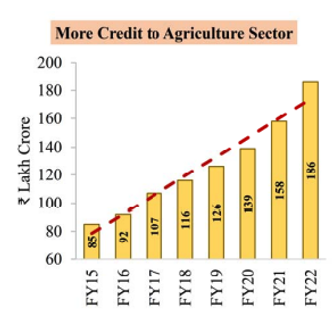
- The allied sectors of Indian agriculture - livestock, forestry & logging and fishing & aquaculture are gradually becoming sectors of buoyant growth and a potential source of better farm incomes.
- Recognising the growing importance of allied sectors, the Committee on Doubling Farmers’ Income (DFI, 2018) considers dairying, livestock, poultry, fisheries and horticulture as high-growth engines and has recommended a focussed policy with a concomitant support system for the allied sector.
- Therefore the agriculture credit target will focus on allied sectors like animal husbandry, dairy and fisheries.
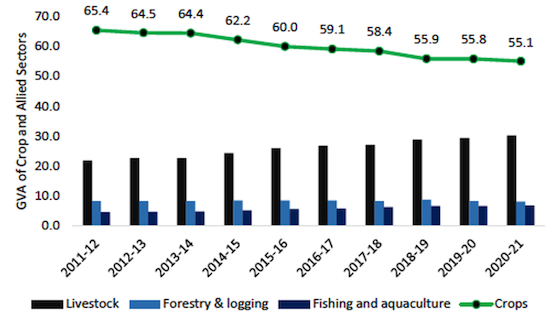
New Sub Scheme of PMSY
- Government will launch a new sub-scheme of PM Matsya Sampada Yojana with targeted investment of ₹ 6,000 crore to further enable activities of fishermen, fish vendors, and micro & small enterprises, improve value chain efficiencies, and expand the market.
- This would not only improve value chain efficiencies in the fishery/sector but also expand the market for fish and fish products inside and outside the country.
- Further, GoI has also reduced custom duty on key inputs for domestic manufacture of shrimp feed. This would enhance the export competitiveness of marine products, particularly shrimps.
- As in the last financial year, marine products recorded the highest export growth benefitting farmers in the coastal states of the country.
Announcements for Cooperatives
- For farmers, especially small and marginal farmers, and other marginalised sections, the government is promoting cooperative-based economic development model.
- A new Ministry of Cooperation was formed with a mandate to realise the vision of Sahakar Se Samriddhi.
- To realise this vision, the government has already initiated computerisation of 63,000 Primary Agricultural Credit Societies (PACS) with an investment of ₹ 2,516 crore.
- In consultation with all stakeholders and states, model bye-laws for PACS were formulated enabling them to become multipurpose PACS.
- A national cooperative database is being prepared for country-wide mapping of cooperative societies.
- With this backdrop, GoI will implement a plan to set up massive decentralised storage capacity. This will help farmers store their produce and realize remunerative prices through sale at appropriate times.
- The Budget vowed to ensure creation of grain storage capacity in each panchayat through Primary Agricultural Credit Societies (PACS). India lacks in terms of the good and scientific Agricultural Infrastructure facilities at the Village/community Level.
- This decision of the Union Government will provide necessary avenues for the PACS and other primary societies to establish state-of-the-art infrastructure for providing various storage and warehouse services to the farmer members of co-operatives.
- This will help farmers to arrest distress sales, store their produce locally at affordable cost and realise remunerative prices through sale at a later period.
- The government will also facilitate setting up of a large number of multipurpose cooperative societies, primary fishery societies and dairy cooperative societies in uncovered panchayats and villages in the next 5 years.
- Cooperation is a value to be cherished. In realizing Prime Minister’s goal of “Sahkar se Samriddhi”, and his resolve to “connect the spirit of cooperation with the spirit of Amrit Kaal”, in addition to the measures proposed above, GoI further proposed following things for cooperative societies to increase business through co-operatives:
- New co-operatives that commence manufacturing activities till 31.3.2024 shall get the benefit of a lower tax rate of 15 per cent, as is presently available to new manufacturing companies.
- To provide an opportunity to sugar co-operatives to claim payments made to sugarcane farmers for the period prior to assessment year 2016-17 as expenditure. This is expected to provide them with a relief of almost Rs 10,000 crore.
- Provide a higher limit of ₹ 2 lakh per member for cash deposits to and loans in cash by Primary Agricultural Co-operative Societies (PACS) and Primary Co-operative Agriculture and Rural Development Banks (PCARDBs).
- Provide a higher limit of ₹ 3 crore for TDS on cash withdrawal.

Budget Allocation
Ministry of Agriculture
- Agriculture, Cooperation and Farmers’ Welfare, which implements policies and programmes related to farmer welfare and manages agriculture inputs, and Agricultural Research and Education, which coordinates and promotes agricultural research and education.
- The Ministry has been allocated ₹ 1,25,036 crore in 2023-24, 5% greater than the revised estimates for 2022-23.
- The Ministry of Agriculture accounts for 2.77% of the total Union Budget. The increase in expenditure is on account of marginal increase in the allocation for schemes such as Modified Interest Subvention Scheme (5%) and the Pradhan Mantri Fasal Bima Yojana (10%).

Budget Allocation for the Ministry of Agriculture and Farmers’ Welfare (in ₹ crore)

Allocation Out of Total Budget
Major Schemes
- 77 % of the Ministry’s estimated expenditure is allocated towards three schemes (See Table Below). Allocation for Pradhan Mantri Kisan Samman Nidhi (PM-KISAN), which is the largest scheme under the Ministry has remained the same as the revised estimates of 2022-23 at ₹ 60,000 crore. Means no Change in allocation of PMKISAN from the last budget.
- 48 % of the allocation to the Ministry in 2023-24 is towards PM-KISAN.

Allocation to major schemes (in ₹ crore)
National Mission on Natural Farming
- To motivate farmers to adopt chemical free farming and enhance the reach of natural farming, the Government has formulated National Mission on Natural Farming (NMNF) as a separate and independent scheme from 2023-24 by up scaling the Bhartiya Prakritik Krishi Paddati (BPKP).
- Government is promoting natural farming through a sub-scheme namely Bharatiya Prakritik Krishi Paddhati (BPKP) under Paramparagat Krishi Vikas Yojana (PKVY) since 2019-2020.
- The success of NMNF will require behavioural change in farmers to shift from chemical based inputs to cow based locally produced inputs and thus requires continuous creation of awareness, training, handholding and capacity building of farmers in the initial years.
- The provision of ₹ 459 crores for 2023-24 has been proposed after careful consideration and the requirement of increase of budget is not anticipated at this stage.
Fertilizer Subsidies
- The Ministry of Chemicals and Fertilisers is responsible for the production, distribution and pricing of fertilisers.
- However, the Ministry of Agriculture and Farmers’ Welfare is responsible for assessing its requirements.
- The Agriculture Ministry is also responsible for promoting balanced use of fertilisers, i.e., ensuring that various nutrients and micronutrients are used in proper combinations. Three major nutrients used in fertilisers include Nitrogen (N), Phosphorous (P) and Potash (K).
- Fertilisers are subsidised through a urea subsidy (which contains nitrogen) and a nutrient-based subsidy for P and K fertilisers.
- Subsidy is provided to fertiliser manufacturers and importers so that farmers can directly purchase them at subsidised rates.
- In 2023-24,
Rs 1,75,103 crorewas budgeted for fertiliser subsidies.

Allocations of Different Ministries

Old Scheme Allocations
Water for Drought Prone Region
- In the drought prone central region of
Karnataka, central assistance of ₹ 5,300 crore will be given to Upper Bhadra Project to provide sustainable micro irrigation and filling up of surface tanks for drinking water.
Green Growth
- Hon’ble Prime Minister has given a vision for LiFE, or Lifestyle for Environment, to spur a movement of environmentally conscious lifestyle. India is moving forward firmly for the “panchamrit” (five major goals) and net-zero carbon emission by 2070 to usher in green industrial and economic transition.
- This Budget builds on our focus on green growth.
- Indian Council of Agricultural Research (ICAR), Ministry of Agriculture and Farmers Welfare, Government of India launched a flagship network project National Innovations in Climate Resilient Agriculture (NICRA) in 2011.
- The project aims at strategic research on adaptation and mitigation, demonstration of technologies on farmers’ fields and creating awareness among farmers and other stakeholders to minimize the climatic change impacts on agriculture.
- Climate change has become an important area of concern for India to ensure food and nutritional security for growing population.
- The impacts of climate change are global, but countries like India are more vulnerable in view of the high population depending on agriculture.
- In India, significant negative impacts have been implied with medium-term (2010-2039) climate change, predicted to reduce yields by 4.5 to 9 percent, depending on the magnitude and distribution of warming.
PM-PRANAM
- PM Promotion of Alternate Nutrients for Agriculture Management Yojana will be launched to incentivize States and Union Territories to promote alternative fertilizers and balanced use of chemical fertilizers.
- According to the report of the standing committee on chemicals and fertilisers, a representative of the department informed the committee that at the end of three years, savings would be 45.78 lakh metric tonnes of fertilisers through the implementation of the PM-PRANAM. “In monetary terms, it would be around Rs 20,000 crore,” the representative said.
- The PM-PRANAM is aimed at restoring the “health of Mother Earth” through promoting balanced/sustainable use of chemical fertilisers, adopting alternate fertilisers such as organic, bio and nano fertilisers; and promoting natural and organic farming.
- Under the PM-PRANAM, 50 per cent of the fertiliser subsidy saved by a State or Union Territory in a particular financial year by way of a reduction in consumption of chemical fertilisers (Urea, DAP, NPK, MOP) compared to the previous 3 years’ average consumption, will be given to that state or UT as a grant. The grant will be provided during 2023-2026.
GOBARdhan scheme
500new ‘waste to wealth’ plants under GOBARdhan (Galvanizing Organic Bio-Agro Resources Dhan) scheme will be established for promoting circular economy.- These will include 200 compressed biogas (CBG) plants, including 75 plants in urban areas, and 300 community or cluster-based plants at total investment of Rs 10,000 crore.
- In due course, a 5 per cent CBG mandate will be introduced for all organizations marketing natural and bio gas.
- For collection of bio-mass and distribution of bio-manure, appropriate fiscal support will be provided.
Bhartiya Prakritik Kheti Bio-Input Resource Centres
- Over the next 3 years, we will facilitate 1 crore farmers to adopt
natural farming. - For this, 10,000 Bio-Input Resource Centres will be set-up, creating a national-level distributed micro-fertilizer and pesticide manufacturing network.
MISHTI
- Building on India’s success in afforestation,
Mangrove Initiative for Shoreline Habitats & Tangible Incomes, MISHTI, will be taken up for mangrove plantation along the coastline and on salt pan lands, wherever feasible, through convergence between MGNREGS, CAMPA Fund and other sources.
Amrit Dharohar
- Wetlands are vital ecosystems which sustain biological diversity. Now India has
75 Ramsar sites, increase from 26 in 2014. - Local communities have always been at the forefront of conservation efforts.
- The government will promote their unique conservation values through Amrit Dharohar, a scheme that will be implemented over the next three years to encourage optimal use of wetlands, and enhance bio-diversity, carbon stock, eco-tourism opportunities and income generation for local communities.
Youth Power

- To empower Indian youth and help the Amrit Peedhi realize their dreams, government have formulated the National Education Policy, focused on skilling, adopted economic policies that facilitate job creation at scale, and have supported business opportunities.
Pradhan Mantri Kaushal Vikas Yojana 4.0will be launched to skill lakhs of youth within the next three years.- On-job training, industry partnership, and alignment of courses with needs of industry will be emphasized. The scheme will also cover new age courses for Industry 4.0 like coding, AI, robotics, mechatronics, IOT, 3D printing, drones, and soft skills.
- To skill youth for international opportunities, 30 Skill India International Centres will be set up across different States.
- States will be encouraged to set up a
Unity Mallin their state capital or most prominent tourism centre or the financial capital for promotion and sale of their own ODOPs (One District, One Product), GI products and other handicraft products, and for providing space for such products of all other States.
Rural Development
Background
- Rural development has always been on the top priority of policy makers lira country like India where nearly two-third of total population and more than 70 per cent of workforce reside in rural areas.
- The focus of economic policies enunciated in India during the planned era of development has been on the achievement of balanced regional development with special emphasis on inclusive growth. The thrust has been on improving the quality of life of rural masses through proactive socio-economic inclusion and empowerment leading to more access to safe drinking water, sanitation, health care, social security and better employment opportunities.
- In the journey of the country to become
$5 trillion economyby the year2025and thethird largest economyin the world by2027, it is extremely essential to focus on the development of rural economy. - The Ministry of Rural Development has been assigned the responsibility to promote welfare activities in rural India. It takes steps to increase livelihood opportunities, providing social safety nets and improving infrastructure in rural areas for their rapid growth.
Organisation
- The Ministry has two departments:
- Rural development and
- Land resources
- The Department of Rural Development (DoRD) plays a pivotal role in the implementation of Government schemes targeted at employment generation, poverty alleviation, infrastructure development and provision of basic services in rural area.
- On the other hand, The Department of Land Resources (DoL) implements two key schemes:
- Integrated Watershed Development Component of Pradhan Mantri Krishi Sinchayee Yojana and
- Digital India Land Records Modernisation Programme (DILRMP)
Budget Allocations
- The Ministry of Rural Development is allocated ₹ 1,59,964 crore in 2023-24.
- Allocation to the Deaprtment of Rural Development is ₹ 1,57,545 crore.
- Allocation to the Department of Land Resources is ₹ 2,419 crore.
Major Schemes under the Department of Rural Development
Mahatma Gandhi National Rural Employment Guarantee Scheme
- It declined due to unusually high expenditure on Mahatma Gandhi National Rural Employment Guarantee Scheme during the COVID-19 pandemic period.
- Rural Employment Programmes Wage and self-employment generation programmes are always perceived to be effective in a rural set-up which is otherwise riddled with high incidence of poverty, low work participation and increased casualisation of labour.
- The Budget, considered the absorption capacity of implementing States/UTs and allocated ₹ 60,000 crore to MGNREGA and ₹ 14,129 crore to National Rural Livelihood Mission, the two existing wage and self-employment programmes towards building quality and productive community assets and enterprises.
- In 2023-24, Mahatma Gandhi National Rural Employment Guarantee Scheme accounted for nearly 38 per cent of total expenditure on all centrally sponsored schemes of rural development.
Pradhan Mantri Awas Yojana - Gramin
- Pradhan Mantri Awas Yojana- Gramin (PMAY-G) has been provided the second highest allocation in the union budget 2023-24.
- This scheme, aims at providing financial assistance to the rural poor for construction of pucca houses of 25 sq. mt. with all basic amenities (piped drinking water, electricity connection, LPG gas connection etc.).
- Originally launched in 1985 as Indira Awas Yojana, PMAY-G was revamped in November 2016 with the objective to provide around 3 crore houses to all the eligible rural households by the year 2024.
- The funds allocated to the scheme (Rs. 54,487 crore) comprise nearly 35 per cent of the budgeted expenditure on all the centrally sponsored schemes.
- In the last seven years, the government has dedicated significant efforts towards improving the housing situation in rural areas with the vision of ensuring
Housing for All. - Total expenditure on PMAY-G is ₹ 54,487 crore in 2023-24,
- A total of 2.83 crore houses have been sanctioned and 2.14 crore have been completed by February 10, 2023 under the Scheme.
Pradhan Mantri Gram Sadak Yojana
- Pradhan Mantri Gram Sadak Yojana (PMGSY) is the third most momentous centrally sponsored scheme of rural development.
- It was launched on 25 December 2000 by the then Prime Minister Sh. Atal Bihari Vajpayee as the fully funded central Government scheme.
- The primary objective of the scheme is to promote economic activities in rural India by providing all-weather road connectivity to the eligible unconnected rural habitations.
- The scheme has been allocated ₹ 19,000 crore in 2023-24, accounting for nearly 12 per cent of the total budget of Department of Rural Development.
- The scheme has had immensely positive impact on agriculture, health, education, employment generation and thus providing access to basic services and lifting the income of rural masses.
National Rural Livelihoods Mission (NRLM)
- NRLM was launched by the Government of India in June 2011.
- It was renamed as
Deendayal Antyodaya Yojana-National Rural Livelihood Mission (DAY-NRLM)on March 29, 2016. - It aims at creating diversified and gainful self-employment to the rural poor through sustainable livelihood enhancements and improved access to financial services.
- The scheme seeks to promote and strengthen the SHGs which in turn are expected to mediate the livelihoods of the rural poor.
- The programme envisages covering of all the rural poor households to be organised in 70-75 lakh SHGs at the village and cluster level by 2024-25.
- Presently, the scheme covers 737 districts spread over 2,68,675 Gram Panchayats and 7,40,845 village of the country.
- The budget allocation to the Mission is
₹ 14,129 crorein 2023-24.
National Social Assistance Programme (NAP)
- NAP is a welfare programme which comprises of many sub-schemes aimed at providing public assistance to citizens in case of unemployment, old age, sickness and any form of disability. The scheme has been in existence since 1995.
- The majors schemes under this programme include Indira Gandhi National Old Age Pension Scheme, Indira Gandhi National Widow Pension Scheme, Indira Gandhi National Disability Pension Scheme, National Family Benefit Scheme and Annapurna Scheme.
- In 2022-23, the Programme was allocated
₹ 9,652 crore.
Shyama Prasad Mukherji Rurban Mission (SPMRM)
- Launched on 21 February 2016.
- SPMRM is a unique programme, designed to deliver catalytic interventions to rural areas, on the threshold of growth.
- It aims at developing cluster of villages that preserve and nurture the essence of rural community life with focus on equity and inclusiveness without compromising the facilities perceived to be essentially urban in nature.
- The main objective is to bridge the rural-urban divide viz; economic, technological and those related to modern facilities for stimulating local economic development with emphasis on employment generation in rural areas.
- The mission has the target to create
300 Rurban Clusterswith the matic economic growth points across the country.
Old Scheme Allocations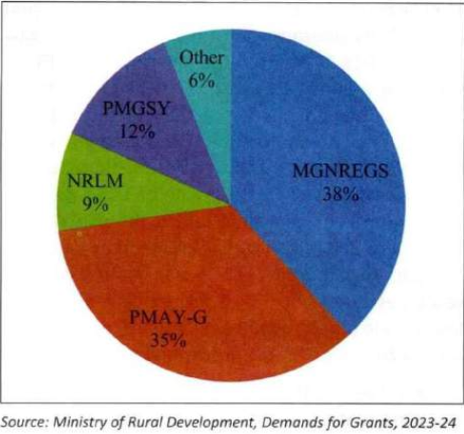
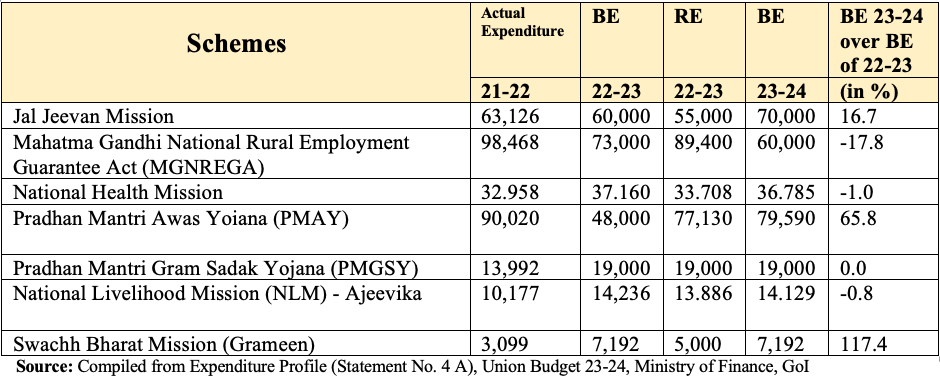
References
- https://cacp.dacnet.nic.in/
- https://www.indiabudget.gov.in/
- https://pib.gov.in/
- https://dfpd.gov.in/food-grain-bulletin.htm
- https://fci.gov.in/
- http://www.nafed-india.com/
- https://cotcorp.org.in/msp
- https://prsindia.org
- Kurukshetra
Which of the following statment is wrong?
Budget
- On 1st February, 2023, Nirmala Sitharaman, the Minister of Finance and Corporate Affairs presented budget in the parliament.
- The Budget Division, part of the Department of Economic Affairs in the Finance Ministry, is responsible for preparing the Budget.
- The constitution does not explicitly mention the term Budget; instead, it refers to it as the Annual Financial Statement.
- As per Article 266 of the Constitution, obtaining Parliamentary approval is necessary to withdraw funds from the Consolidated Fund of India.
- Financial matters are addressed in Articles 112 to 117 of the constitution.
- Furthermore, Article 114 (3) of the Constitution states that no money can be withdrawn from the Consolidated Fund without the enactment of a law, …